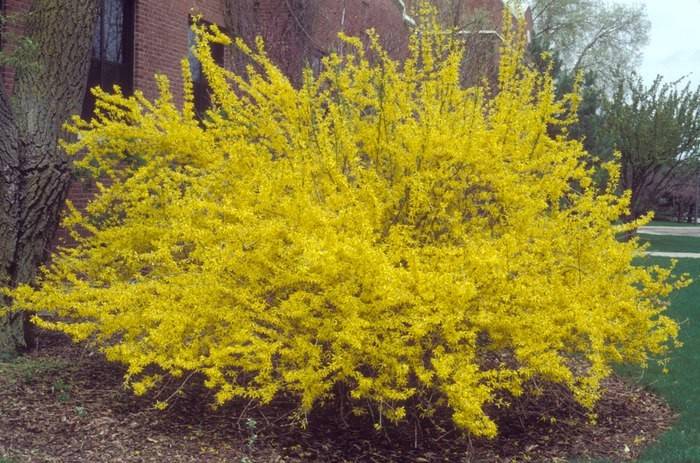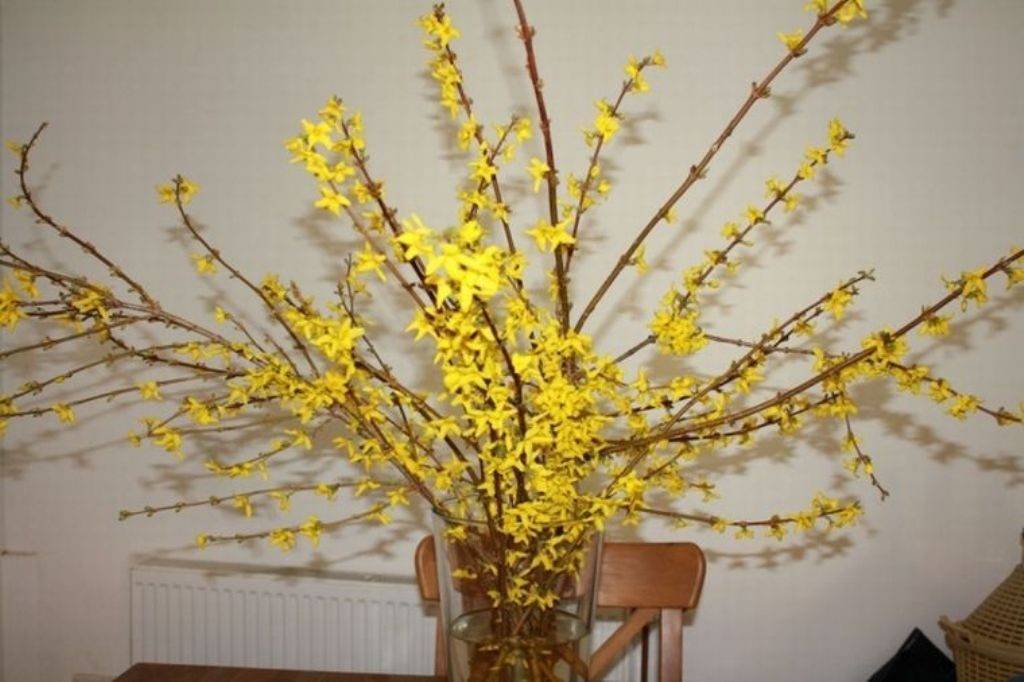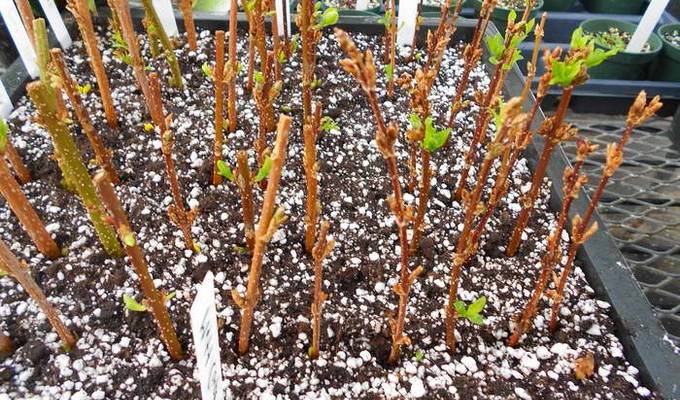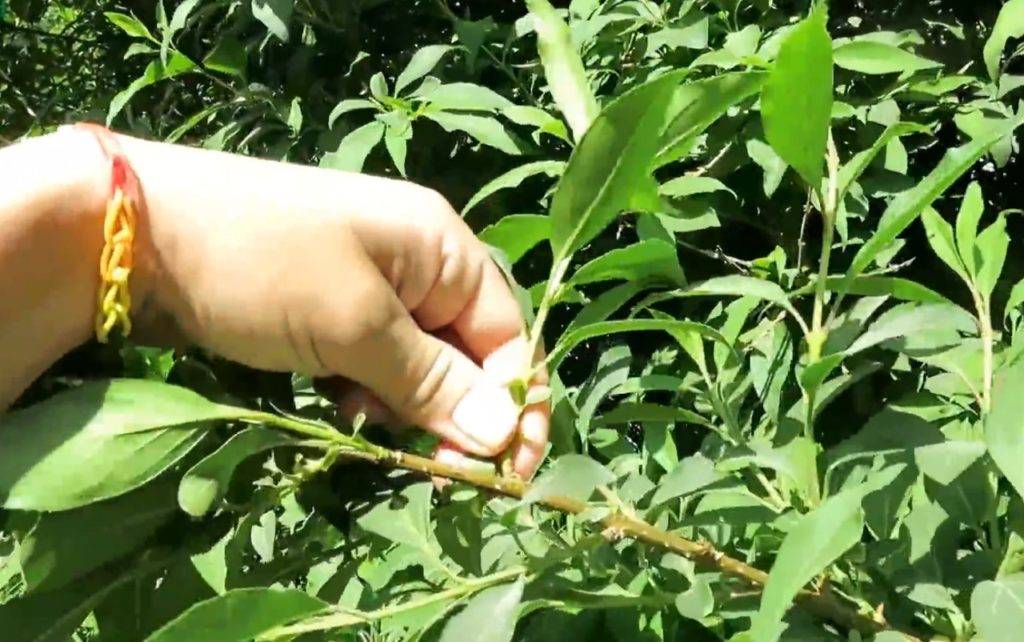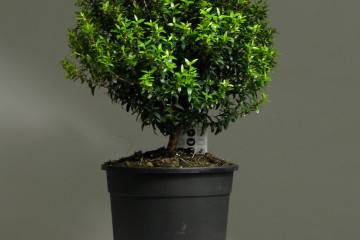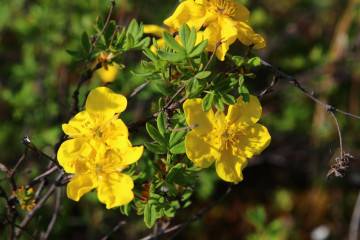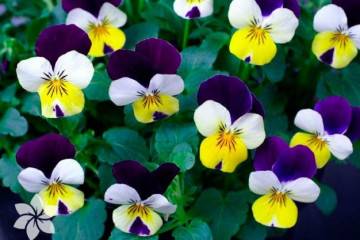Propagation of forsythia by cuttings - how to do it right
Content:
Blooming forsythia will tell you about the onset of spring. As soon as the snow melts, this perennial shrub from the Olive family surrounds itself with a cloud of yellow flowers for a month. Flowering occurs at the end of March, in late spring - in April. The leaves do not have time to bloom, they appear after flowering.
When you can graft forsythia
For propagation of forsythia, one of the methods is chosen: by seeds, layering and cuttings. Before deciding how to propagate forsythia, you need to study the features of these methods. Knowing how forsythia reproduces allows you to get high-quality planting material:
- when sowing seeds, the shrub will bloom in 5-6 years;
- layering gives a small yield of planting material;
- the fastest and most convenient way is grafting. For this, green or lignified cuttings are used.
Cuttings can be carried out at any time of the year, even during the dormant period of the plant. For each season, cuttings with their own characteristics are selected and prepared.
In June, green cuttings are cut, in late summer or early autumn, woody shoots with a diameter of 1 cm are chosen, in late autumn shoots for cuttings are taken larger - 1.5 cm. Reproduction of forsythia by cuttings in summer is preferable, a young bush has time to take root firmly.
How to choose good cuttings
Forsythia cuttings in summer (June) are made using green cuttings. A plant no older than 5 years is suitable for cutting them. Before grafting forsythia in summer, you should choose strong annual shoots 15-20 cm long, which are just beginning to lignify. This moment is easy to guess by the color of the bark: the green color begins to acquire a brown tint. With pruning shears, you need to cut a stalk with 5 buds. When planting, two of them are buried in the soil, and three remain above its level.
Forsythia cuttings can be carried out in late autumn and even in frost-free winters. Until spring, planting material is stored in a cool room. Gardeners who know how to propagate forsythia by cuttings in spring recommend using the branches cut in early February to get a bouquet of yellow flowers for the 8th of March. They are placed in a vessel with water (you can add a little honey there) and put out in a sunny place.
The water in the vessel will have to be changed 2 times a week, and the ends of the branches should be soaked for half an hour in a basin of clean water. In a few weeks, subject to all conditions, they will turn into a beautiful bouquet. After flowering, you should carefully examine the branches: roots may appear on some of them. With the onset of heat, the cuttings are planted in open ground.
Correct separation of cuttings
The shoot chosen for green cuttings must have at least 10 healthy buds. It is divided into cuttings with 2 internodes. The upper cut is made oblique, the lower cut is straight.
In late summer cuttings, the upper cut is made straight, the lower cut at an angle of 45 degrees. The oblique cut increases the area for the formation of future roots.At both ends, a distance of about 2 cm is maintained from internodes to the edge of the cutting.
Rooting cuttings
During the preparation of green cuttings, the leaves are not completely cut off, only the lower part is freed from them, which, when planted, will be in the soil. The remaining leaves will serve as a survival marker. With their help, it will be possible to find out how it was possible to root forsythia with cuttings: if they darken, dry out, then the roots did not appear.
For planting cuttings, light soil with good air permeability is needed. Moreover, it should not be sour. River sand or perlite is added to the fertile land. The place is chosen slightly shaded, without direct sunlight.
You can root forsythia with cuttings, both in the open field and at home. In both cases, it will not hurt to place the cuttings in a solution of a rooting stimulator for several hours.
Landing is carried out, observing certain conditions:
- the distance between the cuttings is kept at 5-7 cm;
- planted at a slight angle;
- deepen to the second or third kidney.
Cuttings for rooting will need a mini-greenhouse, you can cover with a jar. From time to time, the plants are ventilated. The soil in the greenhouse should always be moist to the depth of the seedling planting. Roots usually appear after a month. In the year of rooting, the shoots are not moved to another place. If necessary, they are transferred, without fail preserving a clod of earth.
For the winter, the root system of seedlings is insulated with dry leaves, spruce branches. Plants in seedling boxes are taken out into a cool room. Strong seedlings with good root systems can be planted outdoors if they have been pre-hardened.
Follow-up care after transplant
Rooted bushes are transplanted to a permanent place in the spring. Drainage is laid at the bottom of the planting pit; without it, in a rainy summer, the roots begin to rot. The root system with a clod of earth is placed no deeper than 40 cm from the soil surface. Seedlings can bloom in the same year.
Forsythia is an undemanding plant, but a young bush needs care. The place for it is chosen sunny, otherwise abundant flowering cannot be expected. The shrub can be up to 3 m wide, and this must be taken into account when planting.
Watering
An adult forsythia shrub can easily do without moisture for a long time, but a newly transplanted young bush will suffer in the absence of regular watering.
If the plant is in a depressed state for no apparent reason, you need to dig it up and carefully examine the roots. They may have started to rot. The damaged areas must be cut out. treat live roots with foundation or any antifungal drug. The bush must be transplanted to another place.
Top dressing
With the beginning of the growing season, a complex fertilizing is done with mineral fertilizer. It is repeated after flowering: at this time, the shrub lays future flower buds. The plant does not need autumn feeding.
The soil under the bushes should be regularly weeded and loosened in order to facilitate the access of oxygen to the roots.
Pruning
For the first two years, the seedling is not pruned, they only get rid of the frozen branches. In the future, with the help of pruning, the growth and density of the shrub are controlled. With the help of pruning, the bush can be given various shapes - a ball, a cube, a bowl.
Most of the work is done after flowering is complete. Dead branches are cut in half every 3 years. Old branches are cut strongly, leaving about 5 cm above the ground: lateral shoots will grow from them. With rejuvenating pruning, the shoots are cut by 2/3 of the shoot length. The bush will become thicker, decorativeness will increase.
Pests and diseases
Among flowering shrubs, forsythia is resistant to pests and diseases.
Pests
Of the pests, forsythia is the most annoying aphid. This small and prolific insect pierces young leaves or buds with its proboscis and sucks juice from them.
A dangerous pest is nematodes - microscopic worms that attack both leaves and roots. They suck the sap from the plants, causing them to become depleted. High humidity in the root zone often contributes to the emergence of root nematodes.
Diseases
The most serious diseases that forsythia can suffer from are:
- bacteriosis;
- moniliosis.
Bacteriosis cannot be cured not only in forsythia, but also in other cultures. The disease manifests itself by premature yellowing of the leaves, the veins on them turn black. The plant withers quickly. It must be uprooted and burned. Disinfect the soil.
Moniliosis (monilial burn) is a fungal disease that often appears during flowering. On individual branches, leaves or flowers begin to wither and darken. When a disease is detected, infected branches are cut out to a healthy area and burned. The whole plant is treated with fungicidal preparations.
Preparation for wintering
Many types of forsythia tolerate frosts of 10 degrees, but recently transplanted bushes should be necessarily insulated with a covering material.
Adult plants, despite their frost resistance, should also be prepared for wintering:
- Water liberally and lay a thick layer of mulch around the bush.
- Tilt the branches to the ground and fix.
- For shelter, breathable material is used.
In the spring, after removing the shelter, the branches are straightened, the mulch is shaken off from the roots.
All types of forsythia are considered primrose shrubs, which earned them a worthy place in the garden. The advantages of early flowering are added ease of reproduction, undemanding care, the ability to use in group and single compositions.
